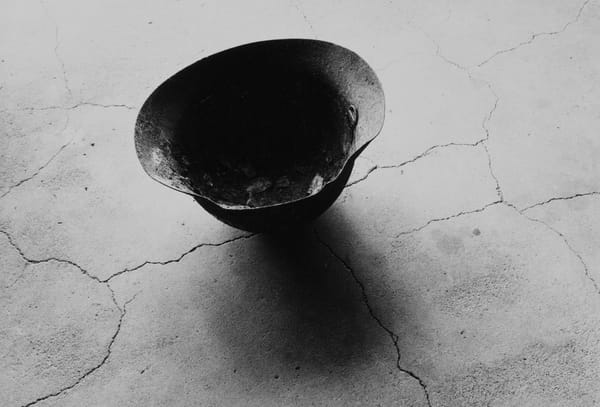Dirty Money: What are the Ethical Implications of Artistic Institutions accepting Money from Oil Co
An Analysis by Fred Fyles
One of the highlights of the Saatchi Gallery’s collection of contemporary art is Richard Wilson’s 20:50. Taking the form of a vast lake of used oil, it creates a black, mirrored surface that simultaneously intrigues and repels. With its surreal air, some visitors feel that the liquid needs to be felt to be believed, only to come away with a sticky residue on their fingers that contaminates everything they touch. Owned by the gallery since 1991, it has been shown in every space the gallery has moved to, with its current iteration taking up the entire basement of their building just off Sloane Square.
Just like the Saatchi Gallery, the Tate Foundation has its own dark connection to oil; yet their river of crude trickles down much further than the basement, reaching down into the core of the institution. I am, of course, talking about the link between The Tate Foundation and their longest-running sponsors, the oil giant BP. Their sponsorship deal is no secret. Indeed, BP seems to have obtained quite a lot of PR mileage from the relationship, with an estimated 30 million visitors to the Tate exposed to their sprightly green & yellow logo, and have expanded into sponsoring a number of other British artistic institutions, including The British Museum, National Portrait Gallery, National Theatre, Royal Opera House, and Almeida Theatre. But if you dig a little deeper it seems that there are some things that BP would rather keep quiet.
In July 2011, the Tate’s Ethics Committee, which includes artists Wolfgang Tillmans and Jeremy Deller, recommended that their sponsorship deal with BP continue. In December it was announced that BP would support a number of institutions – including the Tate – to the tune of £10 million; shortly afterwards a petition numbering 8,000 signatures was delivered to director Nicholas Serota, demanding that the Tate Foundation immediately sever ties with BP, largely due to their impact on the environment. It was the largest outcry since their relationship began in 1990. The management sat on the petition for a total of ten days before giving the trustees less than 24 hours in which to express concerns before the matter was dropped. This signalled the start of a lengthy court battle lasting three years, the outcome of which was that the Tate Foundation was ordered by the Information Commissioner to comply to a number of Freedom of Information requests regarding what was discussed in their meetings with BP. The Tate Foundation has since appealed the decision, having signed a confidentiality agreement with BP in December 2011.
This incident marked the final straw in a long line of indiscretions from BP for many, including pressure group Liberate Tate, founded in 2010 to highlight the ethical problems posed by the relationship through a combination of activism and performance art. Thus far, their protests have included Floe Piece (Jan 2012), in which a piece of ice was transported from the arctic and allowed to melt in the turbine hall, The Gift (July 2012), which saw a group of activists transport a wind turbine blade into the Tate Modern to campaign for increased renewable energy investment, and _Human Cost _(April 2011), during which an activist was stripped naked and covered in oil in the centre of Tate Britain. And they are not alone. Other collectives such as Art Not Oil, Platform, and To BP or Not To BP have all sprung up over the last decade, opposing sponsorship of artistic institutions by oil companies.
So why is this a problem? Well, for starters the record that BP has on environmental issues is far from rosy. One only needs to go back to 20th April 2010, the day oil began seeping into the Gulf of Mexico following an explosion on the Deepwater Horizon rig, to discover the impact BP has on the natural world. Over the next five months around 5 million barrels of oil leaked into the ocean, decimating the marine life in the area, perhaps permanently. While the well was declared sealed on 19th September 2010, there are some reports that state the well continues to leak. What was once described by the National Oceanic and Atmospheric Association as “one of the most productive ocean ecosystems in the world” has now been forever altered; in some areas up to 50% of fish are swimming with open sores; during the first birthing season post-spill, the number of dead baby dolphins washing up on Mississippi and Alabama beaches increased ten-fold; and in 2013 NASA stated that there was a “dearth of marine life” in the area.
Not only has the spill affected the area’s ecosystem, but the lives of the inhabitants have also been altered. In the initial explosion 11 workers died, and since then the long-term effects of oil exposure on clean-up workers has begun to manifest, no doubt thanks to the fact that they were denied respiratory protection and threatened with dismissal if they complained. Furthermore, many workers did not receive safety training to use clean-up chemical Corexit, a legal requirement. Medical professionals are still reporting cases of health problems in local residents, with leading doctors predicting that “liver and kidney disease, mental health disorders, and developmental disorders should all be expected”. Tony Hayward, BP’s CEO at the time, tried to play down concerns, saying that the spill was “very, very modest” compared to the size of the ocean. He also sympathised with local residents saying that he too “wanted my life back”; this is cold comfort for the population, who are still experiencing disturbances to their health. One study in particular found that a third of children living less than 10 miles from the Louisiana and Florida coast had experienced unexplained health problems, including bleeding from the ears and nose.
In fairness to BP, the case could be made that Deepwater Horizon was an isolated incident, which no-one could have predicted. The same argument is difficult to make for Shell, another oil conglomerate that runs significant sponsorship deals in the UK, including with The National Gallery. Their activities in the Niger Delta, where they turned the government against the Ogoni people, on whose land they were working, can only be described as horrific. Following complaints by local elders that they were being exploited, Shell suspended all activity in the area; soon afterwards paramilitary troops raided the villages under orders from the government, and Shell resumed their drilling. The conflict reached a peak in 1995 with the execution of activist Ken Saro-Wiwa, who was accused of murdering four Ogoni chiefs. Immediately afterward Nigeria was suspended from the Commonwealth of Nations, a ban that would last for three years; in 2001 it emerged that two witnesses had been bribed by Shell to give false evidence at the trial; in December 2003 Shell admitted that “we sometimes feed conflict by the way we award contracts, gain access to land, and deal with community representatives”; and in 2009 they offered the family of Saro-Wiwa $15.5 million in damages. They still deny any wrongdoing.
It is clear that neither Shell nor BP have any qualms about destroying both the environment and people’s lives in their quest for further profit. Indeed, despite the fact that research has found that the two companies are responsible for 4.59% of all CO2 emissions since 1750, both are now expanding their operations in Canadian tar sands and exploring the novel technology of fracking. When the Tate, or any other organisation, accepts money from such an organisation, they are implicitly giving their approval of that company’s activities.
In essence, The Tate Foundation is acting as a PR company for BP, hiding their less-than-savory practices under a thin veneer of – that most patronising of terms – public outreach. When one looks at the economic argument it is small wonder that BP decide to sponsor the Tate: as of last year Deepwater had cost BP $42.2 billion, with a recent decision from the Supreme Court that BP were negligent possibly costing them a further $18 billion in the future; for a mere £10 million, spread around a number of UK institutions, BP can gain approval from the UK public. It used to be that arms manufacturers and tobacco companies sponsored artistic ventures (the BP Portrait Prize at the National Portrait Gallery used to be sponsored by Imperial Tobacco), and yet now the immorality of such bodies means accepting funding from them is beyond the pale; why is this not the same for oil companies?
The approval from artistic bodies need not be implicit either; Tate director Nicholas Serota has made his support for oil perfectly clear since the 1980s when he, as director of Whitechapel Gallery, first entered into agreements with BP. Following Deepwater, he made such sentiments even more obvious, refusing to capitulate to mounting pressure from activists: “We all recognise they have a difficulty at the moment”, he said, “but you don’t abandon your friends because they have what we consider to be a temporary difficulty.” Such loyalty is admirable, but perhaps misplaced, especially when one considers that the current Chair of Trustees at the Tate Foundation is Lord Browne, former CEO of BP from 1995-2007, and current owner of fracking company Cuadrilla Resources.
For some, this level of intimacy between the arts and big business is not worrying. British artist Jeremy Deller, who represented the UK at the last Venice Biennale, sees the relationship as inevitable, saying that “art has always had links to power, business, and politics”. This may be so, but with the increasing reach of international companies, it doesn’t seem paranoid to be concerned about the impact they could have on what enters the gallery. In 2011, environmental artist Chris Drury had a work removed from the University of Wyoming; entitled Carbon Sink, it featured a whirlpool of blackened logs on a base of coal, and acted as a comment on the devastating impact of the coal industry on the state’s forests. Following an outcry from Wyoming’s powerful coal lobby, which was soon echoed by state politicians, the piece was removed, less than a year after it was commissioned.
This may be an extreme example, but while BP hasn’t – thus far – removed works from Tate’s galleries outright, the level at which they censor material may be more insidious. This is a sentiment echoed by playwright Mark Ravenhill: “If you spend night after night entertaining corporates, you learn their language”, he says, “It becomes harder to talk to the whole of society. I think there are very few examples of direct intervention – it’s not like you send them a script and see if they like it. But it changes the culture. It’s more gradual than censorship.”
When considering the extreme secrecy that surrounds the Tate Foundation’s dealings with BP - despite the fact that 40% of their funding is from governmental sources – it doesn’t seem at all feckless to question what influence they may have over what is inside the galleries.
Ultimately, whenever a discussion concerns big oil and the arts, people are made to face a choice; would you want BP to stop sponsoring the Tate, if it meant they would no longer be able to function due to lack of funds? I don’t doubt the importance that arts has in this country, both economically and socially, and for me encouraging access to the arts is one of the most vital things a government can do (despite the opinions of Secretary of State for Education Nicky Morgan, who believes “the arts hold kids back”), but this choice of oil or nothing is false.
Instead, there is a third way, which would involve the government dramatically reversing the arts cuts they have put in place thus far, and extending the funding available to the Arts Council. In the most recent governmental budget for the arts, the Southbank Centre, National Theatre, and Royal Shakespeare Company all faced cuts, ENO funding was slashed by 29%, and Barbican funding cut by 18%. When such pressures are placed on institutions, it is understandable that they may look for funding anywhere they can get it, be it from oil companies or financial powerhouses.
But it also encourages a new paradigm, in which the state refuses to support the arts; a process has been put in place – starting two decades ago but significantly ramped up in the last five years – by which arts funding is thought of as an unnecessary luxury, despite the fact that they are economically sound investments, returning £4 for each £1 invested.
As the world becomes more and more interconnected, and environmental issues such as climate change move to the forefront of people’s minds, it seems likely that it will become increasingly difficult for companies such as BP to defend their activities. The interaction between politics and the arts is becoming increasingly unsettling, and people are beginning to take notice; in the wake of the recent Israeli-Palestine conflict the Sao Paulo Biennale dropped the logo of the Israeli Embassy from their programme, and North London’s Tricycle Theatre refused to host the UK Jewish Film Festival until the organisers returned sponsorship from the Israeli Embassy.
Last September, Liberate Tate staged a performance piece in the Tate Modern’s Turbine Hall; entitled Hidden Figures, they held up a giant black square, inspired by the Malevich painting on display at the time, in protest against the censorship of information regarding the sponsorship deals with BP. As anti-oil sentiment becomes more and more apparent, it seems likely that such protests are the tip of a huge iceberg with which the Titanic of big oil is on a direct collision course. The only question now is whether The Tate Foundation will go down with the ship.










